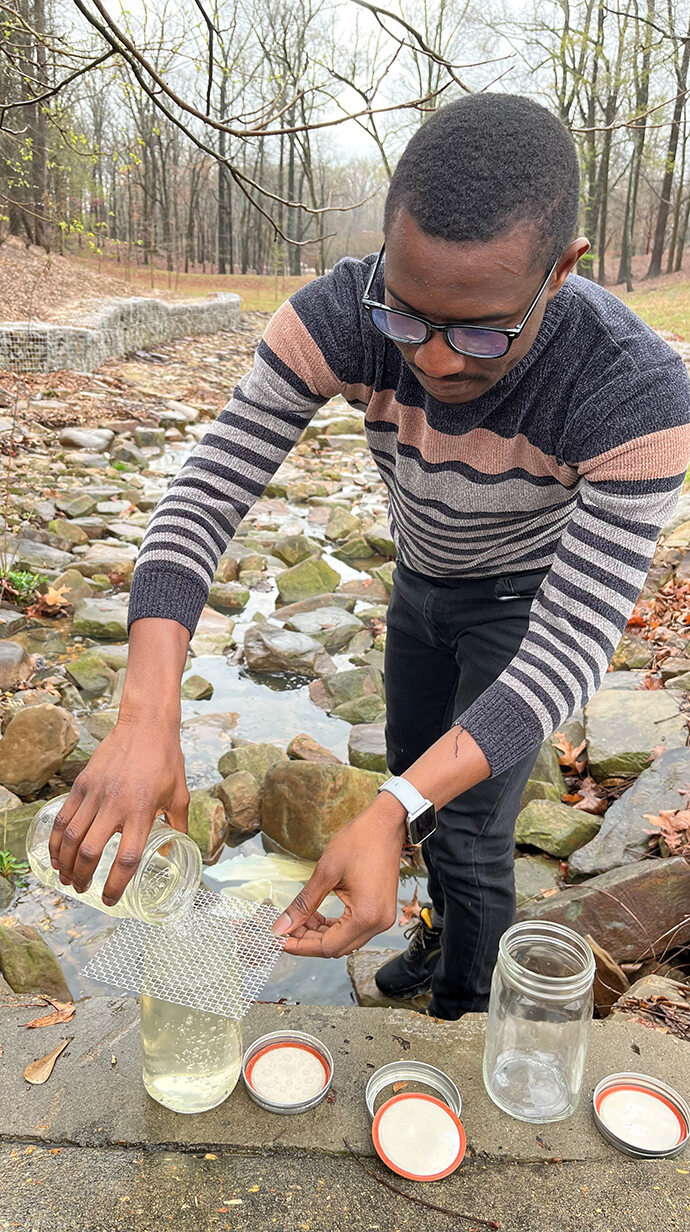Two University of Mississippi Chemistry researchers have been investigating what happens when the rubber meets the road, and their results have led to a published paper.

A researcher adjusts an air senors on a rooftop overlooking a football stadium.
James Cizdziel, professor and interim chair of chemistry and biochemistry, and Boluwatife Olubusoye, a second-year doctoral chemistry student from Lagos, Nigeria, studied the increase and possible effects of the microscopic particles shed by tires near major roadways. Their research has been published in the Bulletin of Environmental Contamination and Toxicology.
“Tire wear particles generally fall in the category of microplastic pollution,” Cizdziel said. “Think about when driving your car; every couple of years, you have to change the tires. Where does all that tread go?

James Cizdziel
“It breaks off into particles and gets into the environment.”
The smallest tire wear particles can pass through the lining of the lungs and into the bloodstream when inhaled, according to research conducted at the Imperial College of London. Tire wear particles have also been found in soil and in stormwater runoff from roadways.
Olubusoye and Cizdziel collected air samples at varying distances along state Highway 6 near Oxford for 10 days. At each of the sampling stations, they found tire wear particles containing toxic compounds, 6PPD-Q and 4-ADPA, with more particles closer to the road.
“We detected these two toxic compounds in the air at each of the locations,” Olubusoye said. “Mind you, this was for just 10 days.
“Humans can inhale these particles, and when they get into their system, these same toxic compounds may be leached from them, exposing people to these compounds as well.”
The chemical compound 6PPD is added to tires in the manufacturing process to prevent them from wearing down quickly. When the compound is exposed to ozone, it creates the toxic 6PPD-quinone, which has been proven deadly to certain fish and detrimental to the environment.
Likewise, 4-ADPA is commonly found in dyes and is used in the rubber manufacturing process. But researchers have found the compound causes difficulty breathing and other health issues in rats, according to a study from the Organisation for Economic Co-operation and Development.

Doctoral student Boluwatife Olubusoye collects stormwater runoff in Oxford to determine whether toxic compounds from tire wear particles are present. Submitted photo
While no definitive study has been completed on the impact of these compounds on humans, Olubusoye said test results in mice indicate how the compounds may react in the human body.
“It causes pathological changes in the lungs, the liver, the kidney and in the testes, all of which can lead to adverse effects,” he said. “While humans are obviously different than mice, these findings are nevertheless concerning and deserve further scrutiny.”
People who live or work on or very near major roadways could be exposed to higher levels of tire wear particles, but the long-term effect of such exposure is not known, Cizdziel said.
“We have evidence that these particles are causing damage in the environment,” he said. “Studies show they are affecting fish, and that may be the tip of the iceberg.
“Certainly, some people that are exposed to these tire wear particles as well, and we don’t know the answer to how this may affect them.”
In the next phase of the study, the Ole Miss team will examine how much of these toxic compounds leach into bodies after being inhaled, as well as develop innovative ways to remove them in runoff from roads before they enter streams, rivers and lakes.